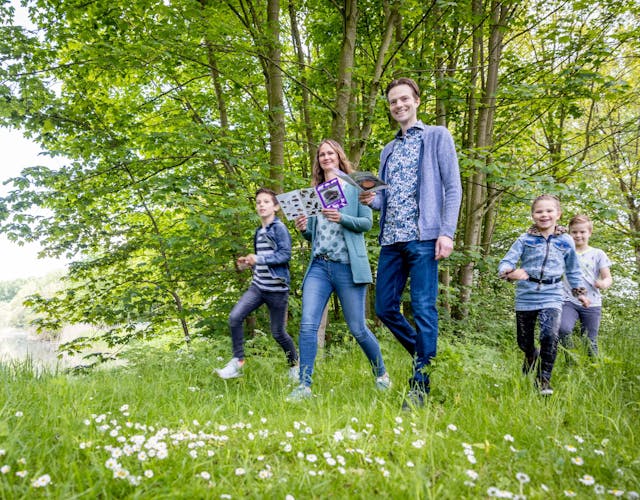
Planting trees
Although the construction of the park started in 1974, the planting of trees and shrubs around the current park had already begun in 1970. Poplar, willow, hawthorn, blackthorn, field maple, alder, dogwood, currant, hazel, willow and hornbeam were planted on a large scale. When it became known that a nature park would be created, ash, maple, oak, beech, elm and spruce were added. Avenues and viewpoints were created and a viewing wall was constructed using soil left over from digging water features. Now, after 50 years, the trees have become giants and the designed park-like appearance has become reality.

Pioneers in the Netherlands
Since 1976, European bison have lived in Natuurpark Lelystad. Over the years, more than 120 of their offspring have been released from Natuurpark Lelystad into dozens of nature reserves in Europe. The animals formed new breeding herds there, so that the number of European bison continued to grow steadily and the survival of the species was guaranteed. There are now several places in the Netherlands where European bison live, these are often descendants of animals from Natuurpark Lelystad.

Escaping beavers
In 1988, the first captive Euopean beavers arrived in Natuurpark Lelystad. At that time there were no wild beavers living in Flevoland. The intention was to breed wth these beavers and release their offspring in National Park De Biesbosch in the southwest of the Netherlands. But the captive beavers had bigger plans. They escaped from their enclosure by digging a tunnel under the road. Once in the wild, they reproduced so well that there are now approximately 300 beavers living all over Flevoland, 20 of which live in Natuurpark Lelystad.

From design sketch to landscape
It is remarkable that the original landscape design of Natuurpark Lelystad was realised almost exactly as the RIJP had envisioned it. The design sketch from 1981 already shows the entire park as we know it today. Only the A6 is still missing! Landscape architect Evert Vermeer regularly visited the park after it was realised and then mused that it had become exactly as he had imagined it.

Przewalski’s breeding program
Due to an ever-shrinking habitat and hunting, the Przewalski’s horse became extinct in the wild in 1968. The ‘Foundation for the Preservation and Protection of the Przewalski’s Horse’ committed itself to saving the horse species. Suitable ‘zoo Przewalski’s’ were collected in a breeding program. Because Natuurpark Lelystad formed the perfect link between the zoo and the wild, the animals were bred here and were given the chance to run wild. The breeding program led to the ‘return’ of Przewalski’s to the Mongolian steppe from 1992 onwards. As a result, Przewalski’s horses now live in the wild again.

Experiencing nature
Recreation and experiencing nature have played an important role since the establishment of Natuurpark Lelystad. The park is no longer just a ‘backyard for the Lelystad residents’ but a tourist attraction with appeal for the whole of the Netherlands. Here you can walk on paved paths through nature, see rare animal species and relax at one of the beautiful viewpoints and afterwards enjoy a cup of coffee on a great terrace. The park receives more than 200,000 nature lovers every year.

Central lake
The current, water-rich central area with several large lakes is the result of sand extraction for the A6. In 1978 and 1979, 1,345,000 m3 of sand was extracted here for the construction of the Rijksweg. These deep sand extraction pits filled with water and turned into lakes with varying depths. Many water birds stay here all year round. For example, trees on the islands in the lake form a resting place for hundreds of cormorants and dozens of species of water birds can be found here, including special species such as common merganser, smew and bittern.

Management by learning
How do you manage a park like Natuurpark Lelystad, if you don’t have a single example? For 50 years, it has been a matter of observing, analyzing, exchanging knowledge, adapting and therefore management by learning. First by the Rijksdienst voor de IJsselmeerpolders, Amsterdam Artis Royal Zoo and later Het Flevo-landschap. An ongoing process. A good example is that in 1975 the mooses were still being fed and now the mooses find their own food by browsing their natural enclosure. A shift from caring for animals to providing space.

Spontaneous nature
Natuurpark Lelystad is a magnet for many ‘wild’ plants and animals due to the great variety in vegetation, open water, copses, forest transitions and grazing. And many new species are still found every year. Although not exactly known, it is estimated that there are about two thousand different species of plants, animals and mushrooms in the park. Many trees, shrubs and plants have been brought in since the beginning of the construction, but many species have established themselves spontaneously, such as roe deer, red fox, pine marten and dozens of species of insects, amphibians, plants and mushrooms.

Park on the seabed
In 1975, the construction of Natuurpark Lelystad began. An area where large grazers such as European bison, Przewalski’s horse and moose live in a natural environment. Created for the new residents of Lelystad and the rest of Flevoland. Once started as a collaborative project between the Rijksdienst voor de IJsselmeerpolders and Amsterdam Artis Royal Zoo, Natuurpark Lelystad has grown into a rich and diverse nature reserve with large bodies of water, exciting vistas and surprising animals. On the occasion of the 50th anniversary of the Nature Park, you will find anniversary signs with the unique history in 10 places. Curious about the whole story? Buy the anniversary book and the special hiking map in the visitor centre.

